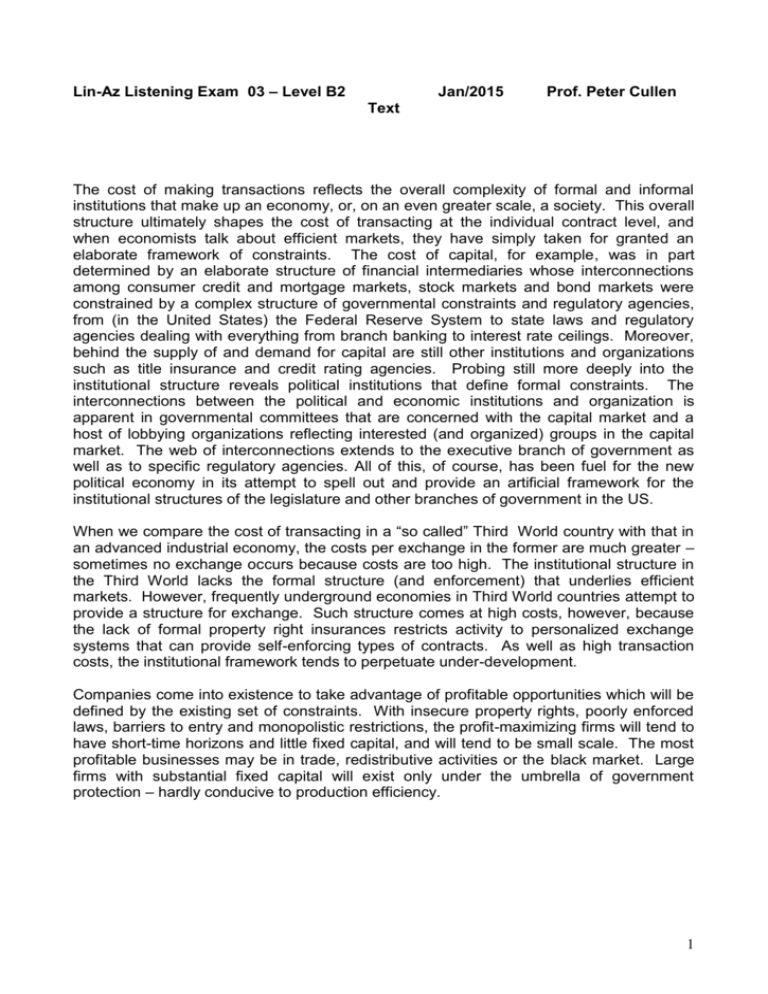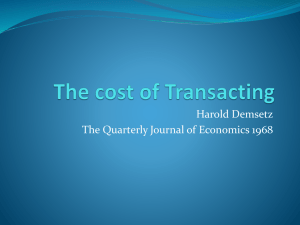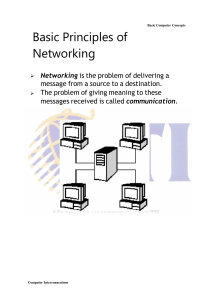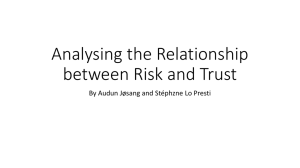LinAZ B2 Listening Exam 3 01 2015
advertisement

Lin-Az Listening Exam 03 – Level B2 Jan/2015 Prof. Peter Cullen Text The cost of making transactions reflects the overall complexity of formal and informal institutions that make up an economy, or, on an even greater scale, a society. This overall structure ultimately shapes the cost of transacting at the individual contract level, and when economists talk about efficient markets, they have simply taken for granted an elaborate framework of constraints. The cost of capital, for example, was in part determined by an elaborate structure of financial intermediaries whose interconnections among consumer credit and mortgage markets, stock markets and bond markets were constrained by a complex structure of governmental constraints and regulatory agencies, from (in the United States) the Federal Reserve System to state laws and regulatory agencies dealing with everything from branch banking to interest rate ceilings. Moreover, behind the supply of and demand for capital are still other institutions and organizations such as title insurance and credit rating agencies. Probing still more deeply into the institutional structure reveals political institutions that define formal constraints. The interconnections between the political and economic institutions and organization is apparent in governmental committees that are concerned with the capital market and a host of lobbying organizations reflecting interested (and organized) groups in the capital market. The web of interconnections extends to the executive branch of government as well as to specific regulatory agencies. All of this, of course, has been fuel for the new political economy in its attempt to spell out and provide an artificial framework for the institutional structures of the legislature and other branches of government in the US. When we compare the cost of transacting in a “so called” Third World country with that in an advanced industrial economy, the costs per exchange in the former are much greater – sometimes no exchange occurs because costs are too high. The institutional structure in the Third World lacks the formal structure (and enforcement) that underlies efficient markets. However, frequently underground economies in Third World countries attempt to provide a structure for exchange. Such structure comes at high costs, however, because the lack of formal property right insurances restricts activity to personalized exchange systems that can provide self-enforcing types of contracts. As well as high transaction costs, the institutional framework tends to perpetuate under-development. Companies come into existence to take advantage of profitable opportunities which will be defined by the existing set of constraints. With insecure property rights, poorly enforced laws, barriers to entry and monopolistic restrictions, the profit-maximizing firms will tend to have short-time horizons and little fixed capital, and will tend to be small scale. The most profitable businesses may be in trade, redistributive activities or the black market. Large firms with substantial fixed capital will exist only under the umbrella of government protection – hardly conducive to production efficiency. 1 Lin-Az Listening Exam 03 – Level B2 Jan/2015 Prof. Peter Cullen ___________________________________________ Name, Date, and Registration Number Questions: Answer all 5 of the following questions. SIMPLE AND CORRECT IS BETTER THAN COMPLICATED AND WRONG. USE SHORT PHRASES AND SENTENCES. This exam requires interpretation and analysis. It is designed to test your ability to apply what you hear to possible discussion areas. 1. What shapes transaction costs at the level of the individual contract? 2. What influenced the cost of capital? (assuming the United States as the author’s point of reference) 3. How is the government involved in the complex set of relationships that create the cost of capital? 4. Are transaction costs higher in the so-called Third World countries or in industrialized countries? 5. What reasons can you give for your answer to question 4? 2 Lin-Az Listening Exam 03 – Level B2 Jan/2015 Answer Sheet Prof. Peter Cullen 1. What shapes transaction costs at the level of the individual contract? The cost of making transactions reflects the overall complexity of formal and informal institutions that make up an economy, or, on an even greater scale, a society. This overall structure ultimately shapes the cost of transacting at the individual contract level 2. What influenced the cost of capital? (assuming the United States as the author’s point of reference) The cost of capital, for example, was in part determined by an elaborate structure of financial intermediaries whose interconnections among consumer credit and mortgage markets, stock markets and bond markets were constrained by a complex structure of governmental constraints and regulatory agencies 3. How is the government involved in the complex set of relationships that create the cost of capital? The interconnections between the political and economic institutions and organization is apparent in governmental committees that are concerned with the capital market and a host of lobbying organizations reflecting interested (and organized) groups in the capital market. The web of interconnections extends to the executive branch of government as well as to specific regulatory agencies. All of this, of course, has been fuel for the new political economy in its attempt to spell out and provide an artificial framework for the institutional structures of the legislature and other branches of government in the US. 4. Are transaction costs higher in the so-called Third World countries or in industrialized countries? Yes 5. What reasons can you give for your answer to question 4? The institutional structure in the Third World lacks the formal structure (and enforcement) that underlies efficient markets. However, frequently underground economies in Third World countries attempt to provide a structure for exchange. Such structure comes at high costs, however, because the lack of formal property right insurances restricts activity to personalized exchange systems that can provide self-enforcing types of contracts. As well as high transaction costs, the institutional framework tends to perpetuate underdevelopment. 3









